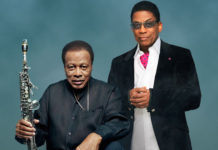
Last week, Kendrick Lamar released a new album titled “To Pimp a Butterfly.” The album has a unique sound to it — more jazz than hip-hop, with bits of spoken word poetry scattered throughout. In each song, Kendrick conveys a detailed, nuanced message that he summarizes in a conversation-style poem with the deceased-rapper Tupac at the end of the album. Many critics hailed the album as Kendrick’s best yet.
But one of the most interesting things about Kendrick’s album isn’t its artistic achievement. It was the fact that it was the most streamed album ever on the music streaming service Spotify. “To Pimp a Butterfly” was streamed 9.6 million in its first day of availability, according to The Fader.
It was reported that Kendrick made $1 million off of those streams from that single day.
But if that weren’t enough, the next day the album broke its own record, amassing 9.8 million streams.
Streams download as you watch or listen, unlike the iTunes downloads that were so popular in the early 2000s. Some popular music streaming services are Spotify, Rdio, Beats Music, Pandora radio, and SoundCloud. Streaming media isn’t the same as downloading it — it’s more like a rental than buying it — and usually is priced differently because of that. This can pose a problem if you have a bad connection — no one likes to see a loading bar slowly buffering a YouTube video.
The streaming success is an important milestone. Not only does it firmly establish the importance of streaming services like Spotify, it also says a lot about where the music industry is going as a whole. Downloads and intentional purchases used to be the main way that people got music, movies and other types of entertainment. Ninety-nine cent iTunes singles are a thing of the past for a simple reason: Listeners can get that same song for free on YouTube or SoundCloud, which on top of being free, is often faster than logging into iTunes and waiting for the file to download.
Thanks to the digital transition, art is no longer what it used to be. Before the internet, music, movies, TV shows, etc. were confined to physical media like vinyl, CDs, DVDs and tape cassettes. According to an article on Vox.com, when media transitioned to digital, it became incredibly easy to copy, and art suddenly lost its scarcity.
Suddenly the most convenient way to get music became the most popular way to get music. It makes perfect sense: why would you pay for something when you can get it for free? The Vox article brings up the point that people no longer want to pay for music, opting instead to pay for experiences like concerts. Jimmy Lovine, a music executive for Beats Music, said that people will not pay to simply access music because they want more.
Kendrick’s album was streamed so many times because that was the easiest, and the first, way to hear it.
Entertainment as a whole is moving in this direction: Netflix and HBO Go streaming are among the most popular ways to watch TV shows, particularly among young people. YouTube and Vimeo let people upload their own videos.
Even the Billboard 200, the music industry-standard metric for album sales, started counting streams toward its top music lists in November 2014, according to The New York Times.
Billboards rules count 1,500 song streams on services like Spotify, Rdio, Beats Music and Google Play as one album purchase.
Digital technologies like the internet and high-speed networks, which enable streaming instead of requiring slow downloads, are rapidly and significantly changing the face of the entertainment industry. Music is just one lens to look at this phenomenon: video is advancing at just as fast a rate, if not faster.
But milestones like with Kendrick’s record will quickly be surpassed, new technologies will emerge, and the entertainment industry will continue to evolve.
Tyler Gold is a senior majoring in Information Technology and Informatics. For more tech news and updates, follow him on Twitter @tylergold.


















